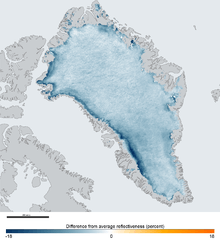Arctic Report Card

The National Oceanic and Atmospheric Administration's Arctic Report Card[1] presents annually updated, peer-reviewed information on recent observations of environmental conditions in the Arctic relative to historical records. The annual updates are released during a press conference at the December American Geophysical Society meeting.
Key highlights are featured on the current report card home page, previous report cards are available online, and each report card is summarized in a short YouTube video.
The audience for the Arctic Report Card is wide, including scientists, students, teachers, decision makers and the general public interested in Arctic environment and science.
2017
The Arctic Report Card for 2017 has contributions from 85 authors spread over 12 countries. The 2017 report contains 12 essays, separated into three sections: Vital Signs, Other Indicators, and Frostbites. A YouTube video video summarizes highlights for this Report Card.
2016
The 2016 Arctic Report Card reflects the combined efforts of 61 authors from 11 different countries. The 12 essays were subject to independent peer-review organized by the Arctic Monitoring and Assessment Programme (AMAP) of the Arctic Council.
In 2016, continuation of long term warming trends and sea ice loss are triggering extensive Arctic Changes. Key highlights are featured on the Home Page, which includes a YouTube video that summarizes the Report Card.
2015
The Arctic Report Card reflected the combined efforts of 72 authors from 11 different countries. The 12 essays were subject to independent peer-review organized by the Arctic Monitoring and Assessment Programme (AMAP) of the Arctic Council.
The 2015 Report Card essays are organized into 3 sections: Vital Signs; Indicators; and Frostbites. Key highlights are featured on the Home Page, which includes a YouTube video that summarizes the Report Card.
In 2015, Arctic sea extent at the end of the winter was the lowest during the satellite record and the winter maximum occurred 15 days earlier than in the past. The sea ice minimum at the end of summer was the 4th lowest extent on record. These changes are having profound impacts in both the marine and terrestrial ecosystems and in sea surface temperatures.
References
- ↑ National Oceanic and Atmospheric Administration (NOAA)'s annually issued Arctic Report Card.